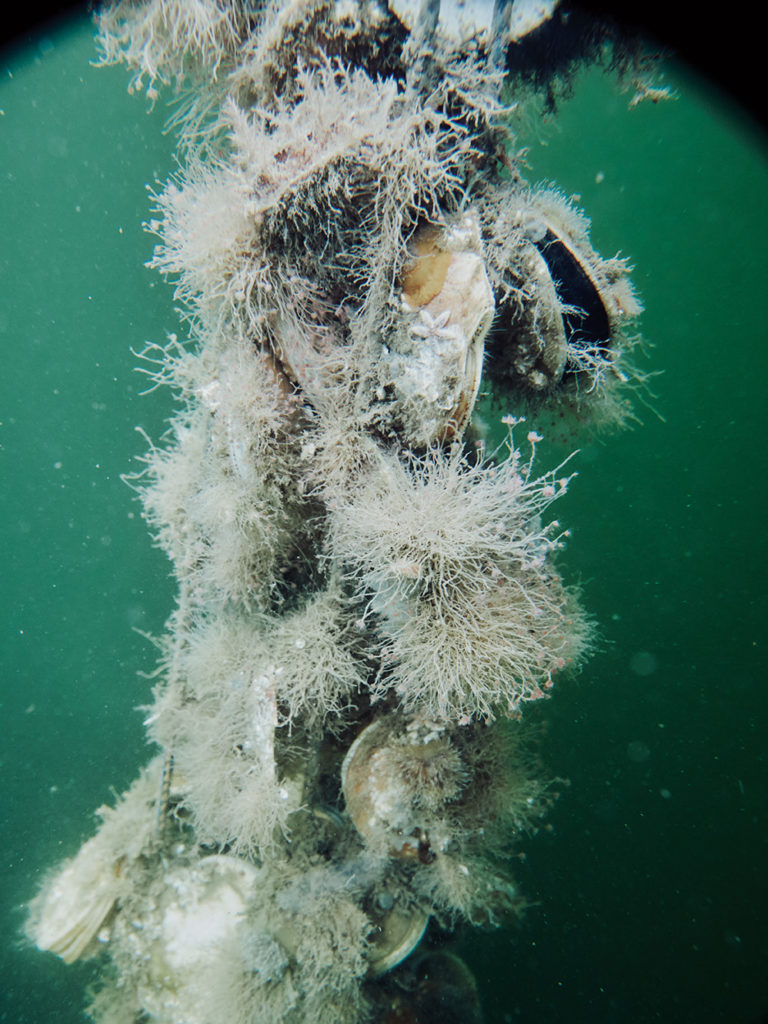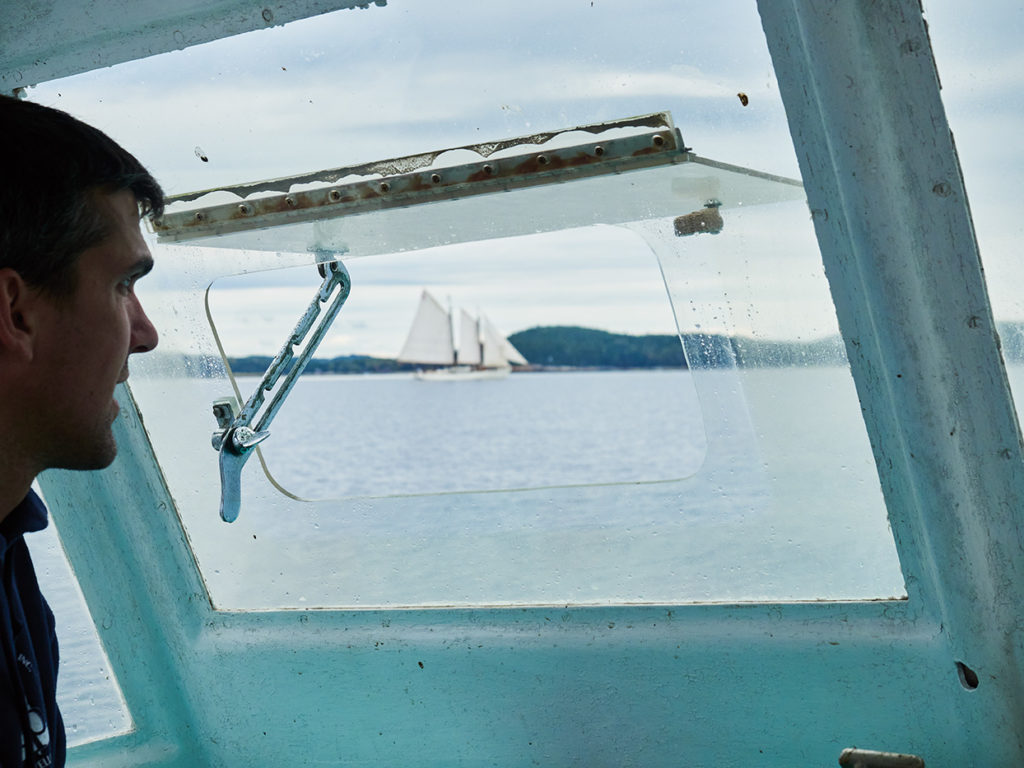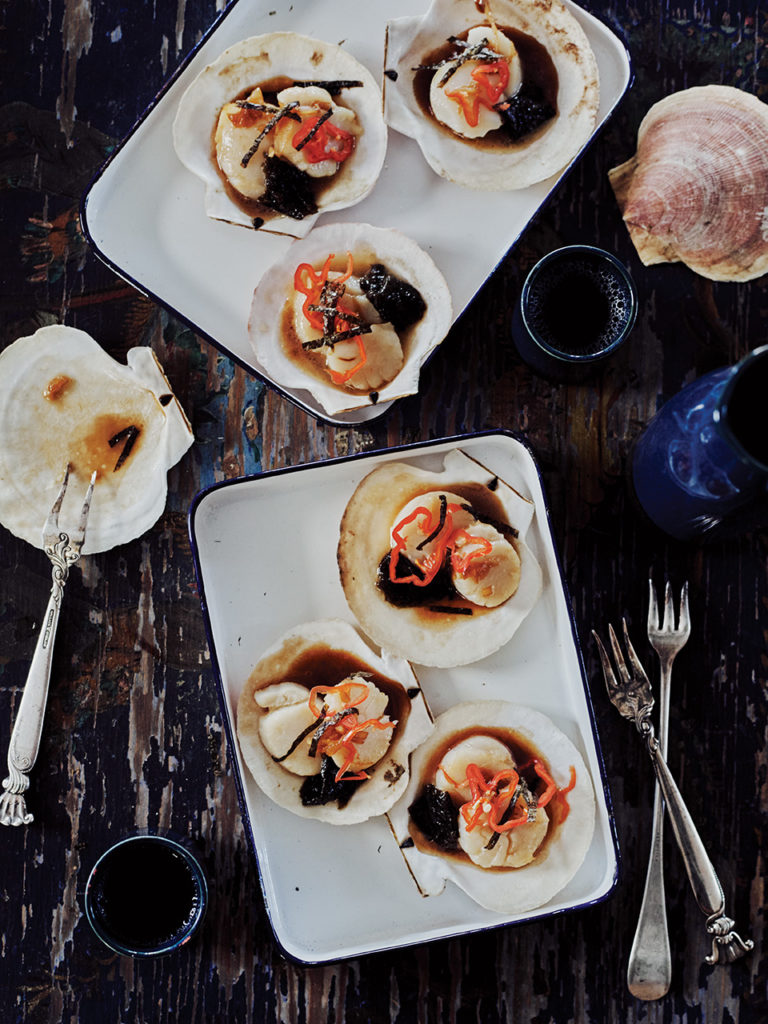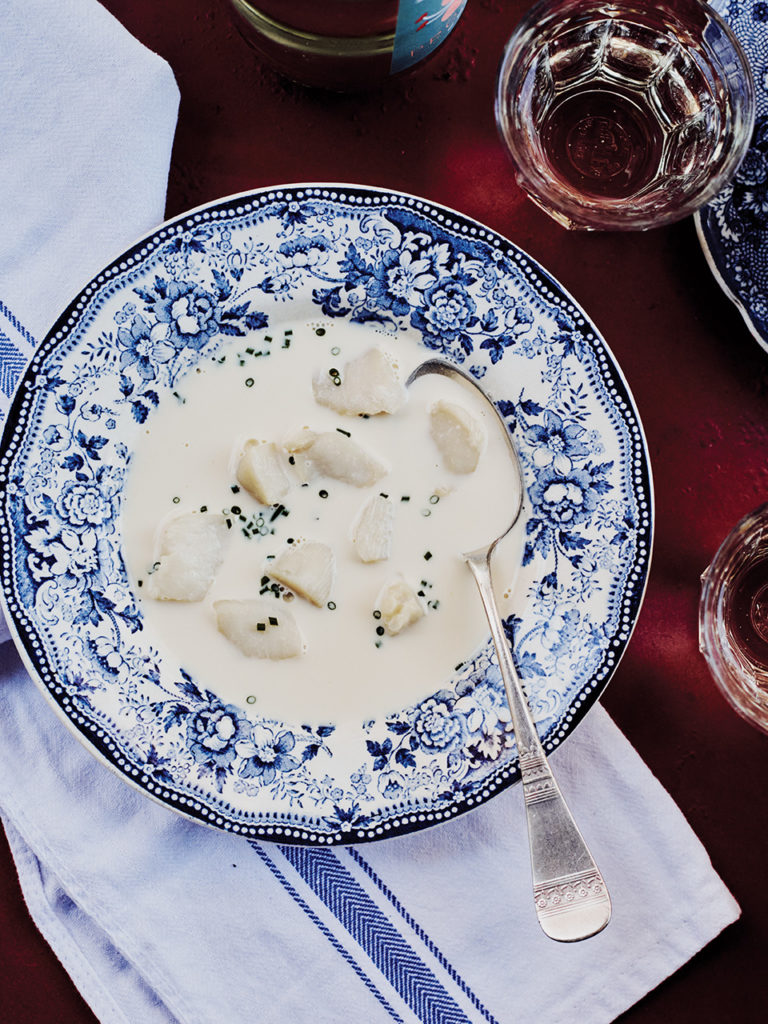Farmed Scallops Take Root in Maine’s Waters
Budding line-grown scallop operations are adding diversity and opportunity to the state’s fishing industry.

Farmed Scallops Take Root in Maine’s Waters
Budding line-grown scallop operations are adding diversity and opportunity to the state’s fishing industry.
By Sandy Lang
Photography by Peter Frank Edwards
Issue: January/February 2022
“Eighty six, eight-seven,” says Andrew Peters, captain of the fishing boat Sammy G. “Ninety,” adds David Loxterkamp, a friend and family doctor from Belfast who’s on board to help for the day. The two men keep counting, the numbers they call out bouncing through the air while the diesel engine chugs. In Grundens orange bibs and teal green rubberized gloves, the men are working through stacked crates of splashing seawater, sorting and counting the day’s haul of scallops. They need 1,200 scallops—cleaned and shucked—to fill the orders for this week.
So, this is a scallop farm.
A few buoys are the only above-water evidence of the bivalves in the water column below us, growing in mesh lantern-shaped bags or suspended individually on rope to which they’ve been attached by a pierced “ear” portion of the shell. (When the young scallops in the mesh bags are large enough, Peters uses a drill press to make a small hole in each shell.) The scallops, seeded three years ago, are finally ready to be harvested this past summer and fall, and Peters has been busy. This is hands-on, hard work. His enterprise, Vertical Bay Maine, focuses on line-grown scallops, and is part of a budding aquaculture sector here that’s already garnered interest from chefs and home cooks—even as just a handful of farmers have jumped in so far.

Scallops growing on a line underwater at Vertical Bay Maine’s operation.
Seawater and rope line on the floor of the 32-foot Sammy G., evidence of the day’s work of cultivating and harvesting scallops.
The cultivation of scallops is growing slowly and steadily as a practice, but line-grown scallops still represent only a tiny fraction of the scallops harvested in Maine, according to Dana Morse, who has studied scallops for more than 20 years. He works with the Maine Sea Grant College Program and University of Maine Cooperative Extension and has attended research trips to Atlantic Canada and to Japan to see the methods used there that might translate well in Maine. The information he gathers is shared with farmers like Peters, who previously worked in breweries and on lobster boats, and he happens to have a degree in geology. “Andrew had fished commercially, lobstering, and he did his homework well to find the lease location in Penobscot Bay—for depth, protection from storms, and access,” Morse says.

Andrew Peters in the wheelhouse of the 32-foot Sammy G. on the way to his scallop farm, Vertical Bay Maine.
Line-grown mussels are often found on menus, and oyster-growing operations have multiplied over the years, but cultivated scallops have been less available. Last summer I was excited to find whole young scallops from PenBay Farmed Scallops out of Stonington in my seafood market—and then to learn of Vertical Bay’s operation off Bucks Harbor. Scallop farms are expanding the seasonality of just-caught Maine scallops because the harvesting of line-grown scallops isn’t limited to the wild scallop-fishing season in the state, typically December to April, when boats fish for the bivalves with mechanical draggers, or divers gather them one by one.
Planning to buy more fresh scallops to bring home, I’ve already earmarked a few recipes.
A Scallop Morning in Maine

Getting ready to motor out to the farm from Buck’s Harbor Marina on the Blue Hill peninsula.
The weather’s mild and clear on this early fall day when photographer Peter Frank Edwards and I are joining a harvest by Vertical Bay Maine, eager to visit the narrow section of water where the scallops are growing. Temperatures are already in the upper 50s at 7:30 on this morning of glassy calm water in Bucks Harbor.
Peters, slim in a hooded sweatshirt, is at the Carolina skiff he keeps at the marina’s dock to motor to and from his fishing boat, which is on a mooring among sailboats and working boats for harvesting lobster and oysters. This harbor, tucked into Brooksville on the Blue Hill peninsula, is the one depicted with such clarity and charm in One Morning in Maine by Robert McCloskey. In the village up the hill, Condon’s Garage and the general store look just like the charcoal drawings in the book.

Peters demonstrates how he pierces a hole in each scallop shell before tying the growing scallop to a dropper line.
.
Scallop farming is a hands- on pursuit at every step; the fan-shaped shells are cleaned of sea squirts, mussels, and other biomass that can attach.
Peters’s 32-foot fishing boat hums along. Its name, Sammy G, is a nod to his wife, Samantha Gilligan Peters, and the investments they’ve made to launch the aquaculture venture, including buying out an original cofounder and purchasing boats and equipment with their savings. She continues her career as a nurse practitioner, and while the young couple worked together to launch the scallop farm, they became new parents: their son, Beauden, was born in 2021. By then Andrew had also earned a plumber’s license. “I promised Sam I’d do that, just in case we needed a backup plan,” he says. He worked plumbing projects into last year, but when he found he could sell as many scallops as he could harvest, he leaned into scallop farming, making it full-time.

Owner Andrew Peters looking out from the wheelhouse on the way to his scallop farm in Penobscot Bay. Before cofounding Vertical Bay Maine, Peters earned a degree in geology from Middlebury College and worked as a sternman on lobster boats.
This isn’t a bad commute at all, I am thinking as we motor out to the farm. It is a jaunt of about 15 minutes to where Peters is cultivating tens of thousands of scallops below the surface along some 400 feet of line. We notice a seal swimming along the way, and in the distance are the masts of a schooner or two. When I see an osprey flying overhead, I imagine its hawk’s-eye view of us, on a boat nearly alone on an expanse of flat water in eastern Penobscot Bay, apart from the bracelet of small islands and ledges of Hog Island, Western Island, Pond Island, and Fiddle Head. Just to the north is Cape Rosier, where Samantha Peters spent summers growing up and where she still has family. When we motor up to the farm’s buoys, the depth gauge shows that the water is 60 to 70 feet deep. Here, Peters and Loxterkamp get to scalloping.
Taste the Merroir

Once collected into bins on the boat deck, where saltwater is kept circulating, the live scallops can be evaluated and counted. I pull on some coveralls, too, and grab some palm-sized live mollusks that are opening and closing, showing glimpses of the soft bodies inside— some with a curved pillow of orange roe. Before counting each one, the men pull off some of the sea squirts and tiny starfish, mussels, and other marine creatures attached to the shells. Sometimes when he’s working out here, Peters says, large schools of mackerel swim past.
Peters lifts a few scallops that have been growing on the line, clips the filaments, and shucks them so we can taste a scallop that’s just a few seconds from the sea. We’re tasting the bivalve’s one large adductor muscle—the dense medallion that’s recognized on menus and plates as a scallop. It’s cool and buttery, tasting absolutely clean and fresh.
Togue Brawn, who sells and promotes scallops through her online business Downeast Dayboat, describes Vertical Bay Maine’s variety as “creamy and sweet with very little brininess.” Brawn, who previously helped to manage the scallop fishery for the Maine Department of Marine Resources, has a knack for describing the differences in the tastes and textures of fresh Maine scallops, depending on where, when, and how they were harvested. “Merroir” is important to shellfish, she explains, just as terroir affects the taste of wine grapes in vineyards.
“I get a little excited about all of the benefits of a more diverse fishery in Maine.”


Shucking (and eating) a scallop while still on the boat.
Besides being a delicious and interesting food source, scallops and other mollusks are beneficial in the ecosystem because they filter water, Brawn notes. The farm-raised scallops are seeded with wild-produced spat (tiny scallops), and no added feed is introduced while the scallops grow. Then mature farmed scallops release spat that can make their way back into wild beds via ocean tides and currents, which could help boost the wild scallop population. Growing the farmed scallop industry can also help to diversify Maine’s working waterfronts, Brawn says. The state’s fishing industry is overwhelmingly reliant on lobstering, which made up more than three-quarters of the total value of commercial landings in 2020, and Brawn notes that scallop farming can provide an alternative to the state’s biggest fishery. “I get a little excited about all of the benefits of a more diverse fishery in Maine,” she says.
Morse, who has assisted Peters and other fisherman in starting their scallop-farming operations, has observed interest in scallop aquaculture in Maine growing in fits and starts over recent years. He notes it’s a labor-intensive prospect, and that it takes a few years “for farmers to get in tune with the ecology and seasonality rhythms of the site.”
He’s optimistic about recent efforts and studies, though, and he hopes enterprises like Vertical Bay Maine will thrive. Morse says more than one seafood broker has told him that a Maine-caught wild scallop “is about as good as you can get in the global marketplace, and the same is true for a farm-raised scallop in Maine. Both taste fabulous.”
The scallop possibilities certainly seem promising after an on-the-boat view. And before we go, Peters mentions that he’s feeling confident after the strong summer season last year—both for scallops and for aquaculture in Maine generally.
I’ve tasted more of the scallops since that day, and I have to agree. I don’t think he’ll even need that backup plan.
Scallops, Two Ways

Scallops with Ginger, Sesame, and Soy
Serves 2 to 4 as an appetizer
In honor of Japan’s influence on Maine’s scallop aquaculture, we found and modified a Japanese bar snack recipe. Scrubbed and washed scallop shells become the serving “plates.”
INGREDIENTS
1 sheet of nori or other dried seaweed 1 cup sake
8 to 10 fresh scallops in the shell
2 tablespoons melted butter
1⁄2 teaspoon sesame oil
Splash of soy sauce
10 thin slices of jalapeño or habañero pepper (for garnish)
Sauce
1 tablespooon soy sauce
1 tablespooon mirin (Japanese cooking wine)
1 tablespooon rice vinegar
1 tablespooon pickled shredded ginger or minced fresh ginger
INSTRUCTIONS
Cut the nori sheet into 8 to 10 pieces and soak in the sake for a few minutes. Drain and set aside. Meanwhile, shuck the scallops. Scrub and dry the shells and set aside. Slice each scallop in half to make two “coins.”
Whisk together the sauce ingredients—soy sauce, mirin, rice vinegar, and ginger—in small bowl.
Heat the butter in a skillet over high heat and add the scallops, sesame oil, and a splash of soy sauce. Sauté for about 1 minute on each side and remove from the pan.
In each clean, dry scallop shell, assemble two pieces of cooked scallop, a piece of marinated nori, and a pepper slice or two, then spoon some sauce over. Serve.

Cream of Scallop Soup
Serves 2
This is adapted from a scallop recipe in one of the final issues of Gourmet, the grand food magazine that, sadly, shuttered in 2009. (We’ve managed to keep a stack of copies that are frequent sources of inspiration.) Here it is, adapted with rosé, a single egg, and a “stock” made with instant soup base.
INGREDIENTS
8 to 10 shucked fresh scallops, each cut in half or thirds and seasoned lightly with salt 2⁄3 cup stock (we used vegetable bouillon)
1⁄4 cup rosé wine
1⁄2 small shallot, finely chopped 2 thyme sprigs
2⁄3 cup heavy cream
1 egg yolk
Salt and fresh cracked black pepper to taste
1 tablespooon chopped chives
INSTRUCTIONS
Lightly sprinkle the sliced scallops with salt. Bring the stock to a boil with the rosé, shallot, and thyme in a heavy saucepan. Stir in the scallops and simmer 2 to 3 minutes. Using a slotted spoon, remove scallops and set aside. Cover the saucepan with a lid and simmer.
Meanwhile, bring cream to a simmer in a small saucepan. Whisk the egg yolk in a bowl, then add a few spoonfuls of heated cream while whisking constantly. Add a dash of salt and black pepper. Whisk the egg-cream mixture into the stock. Warm over low heat until hot but not simering.
Divide the scallops between two warmed bowls, pour some soup over, and garnish with chives.
Read More:
- Branching Out

- 48 Hours in Cape Elizabeth, South Portland + Scarborough

- 4 Unique Winter Weekends

- Brunswick in 48 Hours


